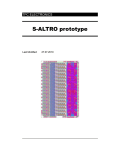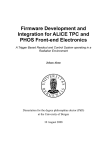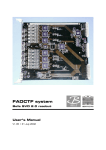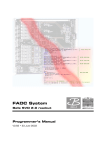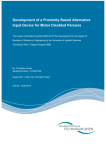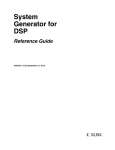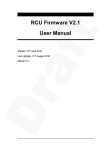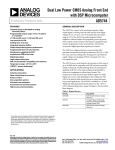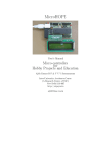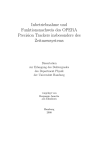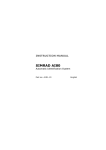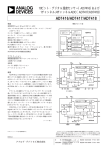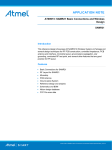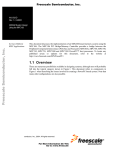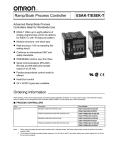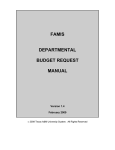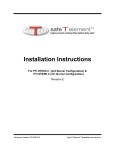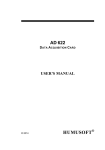Download Digital module requirement specification
Transcript
Digital module requirement specification 1-31 PHOS Board Controller Specification Document name: PHOS BC specification_v3.4.doc Revision: 0.6 (fw version 3.4) Date: Created on 5/23/2007 9:38:00 AM Last saved: 10/31/2007 11:12:00 AM Author: Created by Johan Alme Last saved by Johan Alme Module: PHOS BC Block diagram: PHOS BC specification_v3.4.doc Created by Johan Alme Digital module requirement specification 2-31 Features: • • • • • • • • • • • • • • • Two command interfaces o ALTRO bus interface o Special I2C interface I2C interface is robust with timeout counters and masking of bus input when active transaction to other card. Setting of DACs for bias voltage for High Voltage region Interface to 3 ADCs for verifying voltage and current-levels as well as temperatures. Programmable min/and max thresholds for flagging errors in ADC values. Possible to set how to treat the voltages read back for current calculations: o Store them as is o diff with previous adc value. o Control the order of diff after the expected direction of the current Unlock register for write to read-only registers Monitoring error inputs from Power Regulators Interrupt line to RCU for errors of a severity level craving urgent measures Configurable number of threshold violations from 1 to 3 before interrupt is flagged. Possible to set the FEC in standby mode by turning off voltage regulators and not reporting any warnings/errors. Radiation precautions: o Hamming coded ADC threshold settings o Hamming coded DAC values o TMR of configuration/status registers and threshold config registers Configurable automatic update of DACs Event-length Manager module that generates a hitmap of all ALTRO channels and clocks this out to RCU by controlling dstb for Sparse Readout Mode. Debug registers to test ALTRO bus integrity PHOS BC specification_v3.4.doc Created by Johan Alme Digital module requirement specification 1 3-31 DOCUMENT CONTROL...................................................................................4 1.1 1.2 REVISION HISTORY ..........................................................................................4 REFERENCES ...................................................................................................4 2 MOTIVATION ....................................................................................................5 3 EXTERNAL INTERFACE.................................................................................6 3.1 3.2 SIGNAL INTERFACE .........................................................................................6 TIMING DIAGRAMS ..........................................................................................9 4 REGISTER INTERFACE ................................................................................10 5 FUNCTIONAL REQUIREMENTS.................................................................17 5.1 FUNCTIONAL OVERVIEW...............................................................................17 5.2 MAIN FUNCTIONAL CHANGES FROM PCM V2.0 (HUST) .............................17 5.3 PROJECT SETUP .............................................................................................17 5.3.1 Software ...............................................................................................19 5.4 FUNCTIONAL DETAILS ..................................................................................20 5.4.1 Main Output Signals ............................................................................20 5.4.2 Drivers (Glue Logic)............................................................................20 5.4.3 ALTRO Switch Mask In........................................................................20 5.4.4 ALTRO Interface..................................................................................20 5.4.5 Event-length Manager .........................................................................21 5.4.6 Slow Control Slave Interface ...............................................................22 5.4.7 Interface Decoder ................................................................................23 5.4.8 Registers...............................................................................................23 5.4.9 ADC Interface ......................................................................................24 5.4.10 DAC Interface ......................................................................................25 5.4.11 Hamming Code / Hamming Decoder Module .....................................26 5.4.12 Optional Functionality.........................................................................27 6 OTHER REQUIREMENTS .............................................................................28 6.1 CLOCK STRATEGY .........................................................................................28 6.2 RESET STRATEGY ..........................................................................................28 6.3 POWER STRATEGY.........................................................................................28 6.4 TEST STRATEGY ............................................................................................28 6.4.1 Functional and Post Place and Route Verification .............................28 6.4.2 Functional Coverage ...........................................................................29 6.4.3 Hardware Verification .........................................................................29 7 PHYSICAL IMPLEMENTATION..................................................................30 7.1 TECHNOLOGY ...............................................................................................30 7.2 LOGIC SYNTHESIS .........................................................................................30 7.2.1 Static timing analysis ...........................................................................30 7.2.2 Area estimates......................................................................................30 8 INSTALLATION LOG .....................................................................................31 8.1 8.2 INSTALLATION STATUS .................................................................................31 SOFTWARE ....................................................................................................31 PHOS BC specification_v3.4.doc Created by Johan Alme Digital module requirement specification 4-31 1 Document control 1.1 Revision history Rev. 0.1 0.2 0.3 0.4 0.5 0.5 Rev. date 24.05.07 16.08.07 04.09.07 10.10.07 16.10.07 30.10.07 Document status First draft Updated after design of v3.0 Updated to match version 3.1 of firmware Updated to match version 3.2 of firmware Updated to match version 3.3 of firmware Updated to match version 3.4 of firmware Responsible JA JA JA JA JA JA 1.2 References Ref. No. 1. Doc. Name. PCM_2_0.pdf Rev / Rev date Ver 2.0, Aug 2006 2. AD7416_AD7417_7418.pdf Rev. G [2004] 3. 4. FEE-V1.1b.pdf PHOS-User-Manual.pdf 5. MAX5308-MAX5309.pdf V1.1 27.Sep 05 Rev 2.1 4. Jan 07 Rev 0; 8/01 6. TPC-BC_v2.3.pdf 9/12/2004 7. acex.pdf Ver 3.4, May 03 PHOS BC specification_v3.4.doc Title PCM 2.0 8Based on PHOSS FEE board controller 0.1 (HUST) Analog Devices 10-Bit Digital Temperature Sensor (AD7416) and Four Single-Channel ADCs (AD7417/AD7418) PHOS FEE v1.1 Schematics PHOS Basics for the User Maxim Low-Power, Low-Glitch, Octal 10-Bit Voltage-Output DACs with Serial Interface ALICE TPC Board Controller (version 2.3) ALTERA Acex 1K Programmable Logic Device Family Created by Johan Alme Digital module requirement specification 5-31 2 Motivation The Front End Electronics in PHOS is consisting of one Readout Control Unit (RCU) and 28 Front End Cards (FECs) connected to the RCU via two separate branches. On each FEC an SRAM based FPGA is situated – the Board Controller. Since the Front End Electronics is physically unavailable when PHOS is fully commissioned it must be possible to check the status via software during operation, and quickly respond to any error situation that might occur. The purpose of the Board Controller is to read crucial values on the FEC, such as voltages, currents and temperatures. If these values exceed given programmable thresholds the RCU will be notified. If the severity level is considered to be potentially damaging to the board, the RCU will turn off the given FEC. The PHOS FEC also includes a high voltage section. A very important functionality of the PHOS Board Controller is to set the bias voltage to the charge sensitive amplifiers located in the high voltage section. This must be done since the amplification of the APDs that are used for readout is varying from part to part. This variation is cancelled out with the setting of the DACs that are controlling the bias voltage. This version of the PHOS BC is based on the TPC BC, adding the extra functionality needed for PHOS, and removing some features that are not needed. The basis for the code is the FMD version that is a VHDL implementation of the TPC BC with some modifications. Major changes have been done to this implementation to make it fit for PHOS and to make it more robust. PHOS BC specification_v3.4.doc Created by Johan Alme Digital module requirement specification 6-31 3 External Interface 3.1 Signal interface Signal name rdoclk Dir in Pin 183 rdoclk_en fecclk_40m adcclk adcclk_en rst_fbc out in in out out 121 79 167 122 101 sys_rst bd[39:0] in Inout write Inout 80 [40,41, 44,45, 46,47, 53,54, 55,56, 57,58, 60,61, 63,64, 65,67, 68,69, 70,71, 73,74, 75,83, 85,86, 87,88, 89,90, 92,93, 94,95, 96,97, 99,100] 197 cstb Inout 104 ackn inout 205 error inout 37 1 Sync1 Description 40 Mhz Readout Clock (used as system clock) Enable for the ALTRO readout clock 40 MHz Clock from crystal 20 MHz ALTRO sampling clock. Enable signal for the ALTRO sampling clock Reset from RCU (command decoded) – active low Global reset signal from power up Bidirectional ALTRO bus: [39] Parity bit [38] Bcast bit [37] Boardcontroller/ALTRO [36:25] Channel Address / BC register address [24:20] ALTRO Instruction Code [19:0] Data The write/read signal is driven by the master (RCU) and defines whether the access to the addressed unit is in write/read mode (low/high). The master (RCU) drives the command strobe (CSTB) signal. When asserted, it indicates that a valid word has been placed in the AD bus. The signal also qualifies the WRITE signal. On a WRITE or COMMAND cycle, the addressed unit asserts the ACKN signal to indicate that is has successfully latched the bus content and executed the requested instruction. On a READ cycle, the addressed unit asserts the ACKN to indicate that it has placed the requested data on the bus. The ERROR line is asserted by the slave units to signal the occurrence of an error condition. If the error condition has occurred in an instruction cycle (parity error or Inputs: <clock name>|async: Assumed synchronous with the given clock name or asynchronous Ouputs: <clock_name>[glitch free]|comb: Output generated from the given clock name or combinatorial PHOS BC specification_v3.4.doc Created by Johan Alme Digital module requirement specification trsf inout 39 dstb inout 38 l1 In 102 l2 in 103 trsf_en In 195 ack_en In 193 dolo_en In 186 card_ad[4:0] in bcout_add[4:0] out altrops_en biasps_en shaperps_en allps_error out out out in [176, 175, 174, 173, 172] [192, 191, 190, 189, 187] 126 128 127 78 altrops_error in 180 biasps_error in 168 shaperps_error in 163 oeab_l out 202 oeab_h out 160 PHOS BC specification_v3.4.doc 7-31 instruction code error), the slave does not acknowledge the instruction cycle and asserts the ERROR signal. The ALTRO chip takes the control of the bus by asserting the TRANSFER signal acknowledges this instruction cycle. TRANSFER is kept asserted till the data block has been completely transferred. The data transfer is not necessarily continuous and for this reason each single word, being transferred, is validated by the signal DSTB (Data Strobe). The l1 signal is broadcasted by the RCU to all the FECs. It is used for the distribution of the trigger information. The l1 signal is synchronous with the SCLK signal and lasts for at least two clock cycles. The l2 signal is broadcasted by the RCU to all the FECs. It is used for the distribution of the trigger information. The l2 signal is synchronous with the RCLK and lasts for two clock cycles. trsf_en is used to drive the bi-directional bus bd when transferring an event. ack_en frames ackn, enabling the intrinsic capacitor in the transceiver. dolo_en is used to drive the bi-directional bus bd when reading a register for the later. Hardware address input from branch Output hardware address to the ALTROs: “00000” if ALTROs are turned off or in debug mode card_ad otherwise. Enable signal for ALTRO power regulators Enable signal for bias power regulators Enable signal for shaper power regulators Error flag signalling if output voltage has dropped 5% under nominal value for the power regulator of the digital part. Error flag signalling if output voltage has dropped 5% under the nominal value for ALTRO power regulator. Low parity Error flag signalling if output voltage has dropped 5% under the nominal value for bias power regulator. Low parity Error flag signalling if output voltage has dropped 5% under the nominal value for shaper power regulator. Low parity Setting direction of GTL drivers for altro bus: 0: output (to RCU) 1: input (to FEC) Setting direction of GTL drivers for altro bus: 0: output (to RCU) 1: input (to FEC) Created by Johan Alme Digital module requirement specification oeba_l out 200 oeba_h out 196 ctr_in out 198 ctr_out out 199 rcu_scl rcu_sda_in rcu_sda_out bc_int sensor_scl sensor_sda convst oti_1 oti_2 oti_3 dac_clk_en dac_sclk dac_ldac in in out out out inout out In In In out out out 184 119 120 16 7 8 13 9 11 12 10 17 203 dac_sel[3:0] out [26, 25, 24, 18] dac_din[3:0] out dac_dout[3:0] in test_m_sclk_dn out [30, 29, 28, 27] [36, 31, 15, 14] 166 test_m_sclk_dn out 164 test_m/g in 157 tms_altro0 tms_altro1 tms_altro2 tms_altro3 adc_add[1:0] out out out out out 111 112 113 114 [116, 115] led_red out 62 PHOS BC specification_v3.4.doc 8-31 Setting direction of GTL drivers for altro bus: 1: output (to RCU) 0: input (to FEC) Setting direction of GTL drivers for altro bus: 1: output (to RCU) 0: input (to FEC) Enabling output of GTL drivers for control bus (RCU->FEC): 0: enabled 1: high Z Enabling output of GTL drivers for control bus (FEC -> RCU): 0: enabled 1: high Z 5 MHz Slow Clock for I2C transfers Slow Control Serial data in from RCU Slow Control Serial data out to RCU Interrupt line to RCU, Active Low. I2C clock for AD7417 communication (x3) I2C data line for AD7417 communication (x3) Convert start signal for AD7417 (x3) Over-temperature indicator (Not used) Over-temperature indicator (Not used) Over-temperature indicator (Not Used) DAQ serial clock enable. Active high DAC serial Clock Load DAC. LDAC is asynchronous active-low that updates the DAC outputs simultaneously. If LDAC is driven low, the DAC registers are transparent. Chip-Select output (active-low) daq_sel[0] – HVB 1 – 8 daq_sel[1] – HVA 1 – 8 daq_sel[2] – HVA 9 – 16 daq_sel[3] – HVB 9 – 16 Serial Data Input for the 4 dacs Data Output from the 4 daqs. DOUT is updated on the falling edge of SCLK. LVDS_n Test mode sampling clock generated by the Board Controller. Can only be used of external SCLK is missing LVDS_p Test mode sampling clock generated by the Board Controller Enable signal to enable test sampling clock and RCLK for BC. Active low. Test mode Altro 0, active low (Not Used) Test mode Altro 4, active low (Not Used) Test mode Altro 2, active low (Not Used) Test mode Altro 3, active low (Not Used) Output addressing lines for testmode. Used to address which of the 4*4 channels in the ALTROS should be readout during testmode execution. “00” – ch 0-3, “01” – ch 4-7, “10” – ch 8-11, “11” – ch 12-15 Not Used Output to diode (connected high) Created by Johan Alme Digital module requirement specification led_yellow led_green aux[3:0] out out out usb_sda usb_scl usb_ef usb_rw usb_cs usb_fd[15:0] inout in out in in inout usb_clr_fifo usb_ifclk usb_ff out in out 179 177 [162, 161, 159, 158] 208 207 206 170 169 [150, 149, 148, 147, 144, 143, 142, 141, 140, 139, 136, 135, 134, 133, 132, 131] 125 182 204 9-31 Output to diode (connected high) Output to diode (connected high) Output to diode (connected high) USB interface - Not Used USB interface - Not Used USB interface - Not Used USB interface - Not Used USB interface - Not Used USB interface - Not Used USB interface - Not Used USB interface - Not Used USB interface - Not Used Table 3-1: Signal interface 3.2 Timing diagrams TBA PHOS BC specification_v3.4.doc Created by Johan Alme Digital module requirement specification 10-31 4 Register interface Register name Addr. Type UNLOCK 0x0 RW Allow Brcast Yes L0CNT[15:0] L2CNT[15:0] SCLKCNT[15:0] SLOWCTR_ERR [7:0] CSR0[11:0] 0x0B 0x0C 0x0D 0x0E R(W) R(W) R(W) R Yes* Yes* Yes* No 0x11 RW Yes CSR1[13:0] 0x12 R N/A 2 2 Description One bit unlock register for writing to read only regs for testing. 0: Locked 1: Unlocked Number of L0 triggers received Number of L2a triggers received Sampling clock counter Number of timeout situations in Slow Control Interrupt Mask Register: Default value = 0x1FF [11] HV Update Mode. 0 = The BC updates DAC with update_hv command. 1 = The BC continuously updates DACs [10] Conversion Mode. 0 = The BC reads the content of the monitor ADC with the STCNV command (1B) 1 = monitor ADC converts continuously [9:8] Error Mask. These two bits mask the assertion of the Error line. This line is asserted with the flags registered in CSR1[9:8] 0 = the error is masked 1 = the error asserts the line [7:0] Interrupt Mask. These bits mask the bits of CSR1 [7:0] for the assertion of the Interrupt line Error Status Register: Default value = 0x0000 [13] Value of Slow Control Interrupt line [12] Value of ALTRO bus Error line [11] Slow Control Instruction Error [10] ALTRO error: Registered value of ALTRO bus error line [9] ALTRO bus Instruction Error (to BC) [8] Parity error of ALTRO bus 20 MSB [7] Missing Sampling Clock [6] ALTRO Power, Digital 4.2V & 3.3V and Bias Supply Error [5] Shaper +6.0V Power Supply Error [4] 4.2 V or 3.3 V digital current is higher than thresholds. [3] 4.2 V or 3.3 V digital voltage is lower than thresholds. Legend: W=write, R=read, T= write trigger (not physical registers) PHOS BC specification_v3.4.doc Created by Johan Alme Digital module requirement specification Register name Addr. Type 2 11-31 Allow Brcast Description [2] CSR2[15:0] 0x13 RW Yes CSR3[15:0] 0x14 RW Yes DEBUG[1:0] 0x15 R No CNTLAT CNTCLR CSR1CLR ALRST BCRST STCNV SCEVL 0x16 0x17 0x18 0x19 0x1A 0x1B 0x1C T T T T T T T Yes Yes Yes Yes Yes Yes Yes EVLRDO 0x1D T Yes UPDATEHV BCVERSION[15:0] 0x1E 0x20 T R Yes N/A PHOS BC specification_v3.4.doc 4.0 V, +6.0 V, -6.0 V, 13.5 V analog current higher than threshold. [1] 4.0 V, +6.0 V, -6.0 V, 13.5 V analog voltage lower than threshold. [0] Temp1, Temp2 or Temp3 higher than threshold. Status and Configuration Default value = 0x013F [15:11] Hardware Address (read only) [10] Card Isolated [9:8] Number of times a ADC threshold violation must occur before it is reported [7] Not Used [6] Enables Hamming correction on HVDAC values and Thresholds. [5] Enables DAC clock [4] Enables Sampling Clock [3] Enables Readout Clock [2] Power Switch for Shaper Power Regulator [1] Power switch for Bias Power Regulator [0] Power switch for ALTRO Power Regulator Status and Configuration Default value = 0x2220 [15] This bit is set to 1 when the BC has completed the transaction with the mADC. It is reset at the beginning of every transaction. [14:8] Scevl timeout value. Max num of clks for each transaction on the ALTRO bus when BC is master. [7:0] rdclk / sclk warning ratio [1] Value of Slow Control data line [0] Value of test_mg input Latch L0, L2, SCLK counters Clear L0, L2, SCLK counters Clear Error Status Register Reset all the ALTROs Reset Board Controller to default values Start Conversion / Readout monitor ADC Scan Event-length registers in all ALTRO channels Start readout of Event Length Hitmap register. Update HV Board Controller Version Created by Johan Alme Digital module requirement specification 12-31 Register name Addr. Type VTS_HIGH[14:0] 0x21 R(W) Allow Brcast Yes* VTS_LOW[14:0] 0x22 R(W) Yes* TH_HMGERR_HIG H[14:0] TH_HMGERR_LOW [14:0] HV_FB1[15:0] 0x23 R(W) Yes* 0x24 R(W) Yes* 0x25 R(W) Yes* HV_FB2[15:0] 0x26 R(W) Yes* HV_HVHMGERR1 [15:0] 0x27 R(W) Yes* HV_HVHMGERR2 [15:0] 0x28 R(W) Yes* ADC_DIFF[14:0] 0x29 RW Yes PHOS BC specification_v3.4.doc 2 Description Voltage Temperature Status register: [0] TEMP1 over th [1] D4V0 over th [2] D4V0C over th [3] D3V3 over th [4] D3V3C over th [5] TEMP2 over th [6] A6nV0 over th [7] A6nV0C over th [8] A6pV0 over th [9] A6pV0C over th [10] TEMP3 over th [11] A3V3 over th [12] A3V3C over th [13] A13V0 over th [14] A13V0C over th Voltage Temperature Status register: [0] TEMP1 under th [1] D4V0 under th [2] D4V0C under th [3] D3V3 under th [4] D3V3C under th [5] TEMP2 under th [6] A6nV0 under th [7] A6nV0C under th [8] A6pV0 under th [9] A6pV0C under th [10] TEMP3 under th [11] A3V3 under th [12] A3V3C under th [13] A13V0 under th [14] A13V0C under th Double hamming errors found in ADC high threshold memory . Double hamming errors found in ADC low threshold memory. Compared outputs from DAC for CSP [7:0] CSP 16 – CSP 23 [15:8] CSP 7 – CSP 0 0: DAC not set/Wrong 1: DAC set/Correct Compared outputs from DAC for CSP [7:0] CSP 15 – CSP 8 [15:8] CSP 24 – CSP 31 0: DAC not set/Wrong 1: DAC set/Correct Double hamming errors for the following: [7:0] CSP 16 – CSP 23 [15:8] CSP 7 – CSP 0 Double hamming errors for the following: [7:0] CSP 15 – CSP 8 [15:8] CSP 24 – CSP 31 Sets which ADC values that should be treated as currents in the ADC value and ADC threshold memory. In practice this is a diff between Vprev and Vcurrent Default Value: 0x5294 Created by Johan Alme Digital module requirement specification Register name Addr. Type ADC_DIFF_DIR [14:0] 0x2A R(W) 2 13-31 Allow Brcast Yes* Description Sets the expected direction of the current for the current measurements given by ADC_DIFF register. 0: Current = Vpreviou - Vcurrent 1: Current = Vcurrent – Vpreviou Default Value: 0x0080 TRANS_CNT[15:0] 0x2B R No LAST_ADDR_MSB [7:0] 0x2C R No LAST_VALID_ADDR [15:0] LAST_NOTVALID_ ADDR[15:0] 0x2D R No 0x2E R No ADC Min Threshold Memory[14:0] 0x30 – 0x3E RW Yes ADC Max Threshold Memory[14:0] 0x40 – 0x4E RW Yes ADC Data Memory[9:0] HV DAC settings memory [14:0] 0x50 – 0x5E 0x60 – 0x7F RW Yes RW Yes [15:8] [7:0] Number of acks sent to RCU Number of strobes received from RCU [7:4] MSB of last valid address received. [3:0] MSB of last not valid address received LSB of last valid address received at the FEC LSB of the last not valid address received at the FEC. Min Threshold for the ADCs [15:11] Hamming code [10] 0: Threshold for Voltage 1: Threshold for Current [9:0] Data value Max Threshold for the ADCs [15:11] Hamming code [10] 0: Threshold for Voltage 1: Threshold for Current [9:0] Data value Data values from the ADCs [9:0] Data value High voltage bias value for CSPs 0x60-0x67: CSP 23 down to CSP 16 0x68-0x6F: CSP 0 to CSP 7 0x70-0x77: CSP 8 to CSP 15 0x78-0x7F: CSP 31 down to CSP 24 [15:11] Hamming code [10] Don’t care (not used) [9:0] Value to Write Table 4-1: List of registers that can be accessed externally. Note: The registers marked with “R(W)” and Broadcast “Yes*” can be written to when unlock bit is set. PHOS BC specification_v3.4.doc Created by Johan Alme Digital module requirement specification Memory location name TEMP1-MIN_TH Addr. 0x30 D4V0_MIN_TH[ 0x31 D4V0C_MIN_TH 0x32 D3V3_MIN_TH 0x33 D3V3C_MIN_TH 0x34 TEMP2-MIN_TH 0x35 A6nV0_MIN_TH 0x36 A6nV0C_MIN_TH 0x37 A6pV0_MIN_TH 0x38 A6pV0C_MIN_TH 0x39 TEMP3-MIN_TH 0x3A A3V3_MIN_TH 0x3B A3V3C_MIN_TH 0x3C A13V0_MIN_TH 0x3D A13V0C_MIN_TH 0x3E 14-31 Description Minimum Temperature Threshold for ADC IC13 Default Data Value: 0x0 (disabled) Minimum 4.0V Digital Voltage Threshold Default Data Value: 0x1D8 (= 3.8 V) Minimum 4.0V Digital Current Threshold Default Value: 0x0 (disabled) Alternatively Voltage level used for current calc. Minimum 3.3V Digital Voltage Threshold Default Data Value: 0x1C2 (= 2.9 V) Minimum 3.3V Digital Current Threshold Default Value: 0x0 (disabled) Alternatively Voltage level used for current calc. Minimum Temperature Threshold for ADC IC15 Default Value: 0x0 (disabled) Minimum -6.0V Analog Voltage Threshold Default Data Value: 0x170 (= -6.4 V) Minimum -6.0V Analog Current Threshold Default Value: 0x0 (disabled) Alternatively Voltage level used for current calc. Minimum 6.0V Analog Voltage Threshold Default Data Value: 0x1E8 (= 5.6 V) Minimum 6.0V Analog Current Threshold Default Value: 0x0 (disabled) Alternatively Voltage level used for current calc. Minimum Temperature Threshold for ADC IC14 Default Value: 0x0 (disabled) Minimum. 3.3V Analog Voltage Threshold Default Value: 0x1C2 (= 2.9 V) Minimum 3.3V Analog Current Threshold Default Value: 0x0 (disabled) Alternatively Voltage level used for current calc Minimum 13.0V Analog Voltage Threshold Default Value: 0x1D6 (= 12.6 V) Minimum 13.0V Analog Current Threshold Default Value: 0x0 (disabled) Alternatively Voltage level used for current calc Table 4-2: ADC Minimum Threshold Value Memory. The conversion factors are given in Table 4-4 PHOS BC specification_v3.4.doc Created by Johan Alme Digital module requirement specification Memory location name TEMP1-MAX_TH Addr. 0x40 D4V0_MAX_TH[ 0x41 D4V0C_MAX_TH 0x42 D3V3_MAX_TH 0x43 D3V3C_MAX_TH 0x44 TEMP2-MAX_TH 0x45 A6nV0_MAX_TH 0x46 A6nV0C_MAX_TH 0x47 A6pV0_MAX_TH 0x48 A6pV0C_MAX_TH 0x49 TEMP3-MAX_TH 0x4A A3V3_MAX_TH 0x4B A3V3C_MAX_TH 0x4C A13V0_MAX_TH 0x4D A13V0C_MAX_TH 0x4E 15-31 Description Maximum Temperature Threshold for ADC IC13 Default Data Value: 0xA0 (= 40°C) Maximum 4.0V Digital Voltage Threshold Default Value: 0x0 (disabled) Maximum 4.0V Digital Current Threshold Default Value: 0x00C (=0.36 A) Alternatively Voltage level used for current calc. Maximum 3.3V Digital Voltage Threshold Default Value: 0x0 (disabled) Maximum 3.3V Digital Current Threshold Default Value: 0x011 (= 0.73 A) Alternatively Voltage level used for current calc. Maximum Temperature Threshold for ADC IC15 Default Data Value: 0xA0 (= 40°C) Maximum -6.0V Analog Voltage Threshold Default Value: 0x0 (disabled) Maximum -6.0V Analog Current Threshold Default Value: 0x00F (=0.44 A) Alternatively Voltage level used for current calc. Maximum 6.0V Analog Voltage Threshold Default Value: 0x0 (disabled) Maximum 6.0V Analog Current Threshold Default Value: 0x016 (= 0.764 A) Alternatively Voltage level used for current calc. Maximum Temperature Threshold for ADC IC14 Default Data Value: 0xA0 (= 40°C) Maximum. 3.3V Analog Voltage Threshold Default Value: 0x0 (disabled) Maximum 3.3V Analog Current Threshold Default value: 0x014 (= 0.858 A) Alternatively Voltage level used for current calc Maximum 13.0V Analog Voltage Threshold Default Value: 0x0 (disabled) Maximum 13.0V Analog Current Threshold Default Value: 0x00F (= 0.334 A) Alternatively Voltage level used for current calc Table 4-3: ADC Maximum Threshold Value Memory PHOS BC specification_v3.4.doc Created by Johan Alme Digital module requirement specification 16-31 Memory location name TEMP1 Addr. Description Conv. factor 0x50 Temperature for ADC IC13 D4V0 0x51 4.0V Digital Voltage D4V0C 0x52 D3V3 0x53 4.0V Digital Current Alternatively Voltage level used for current calc. 3.3V Digital Voltage D3V3C 0x54 TEMP2 0x55 3.3V Digital Current Alternatively Voltage level used for current calc. Temperature for ADC IC15 A6nV0 0x56 -6.0V Analog Voltage A6nV0C 0x57 A6pV0 0x58 A6pV0C 0x59 TEMP3 0x5A -6.0V Analog Current Alternatively Voltage level used for current calc. 6.0V Analog Voltage Default Data Value: 0x1E8 (= 5.6 V) 6.0V Analog Current Alternatively Voltage level used for current calc. Temperature for ADC IC14 A3V3 0x5B 3.3V Analog Voltage A3V3C 0x5C A13V0 0x5D 3.3V Analog Current Alternatively Voltage level used for current calc 13.0V Analog Voltage A13V0C 0x5E 0.25°C * ADC counts 8.04mV * ADC counts 29.8mA * ADC counts 6.44 mV * ADC counts 42.9 mA * ADC counts 0.25°C * ADC counts 4.88mV * ADC counts / 1000 8.2V 29.3mA * ADC counts 11.4 mV * ADC counts 34.73 mA * ADC counts 0.25°C * ADC counts 6.44 mV * ADC counts 42.9 mA * ADC counts 26.8 mV * ADC counts 22.3 mA * ADC counts 13.0V Analog Current Alternatively Voltage level used for current calc Table 4-4: ADC Value Memory. Please note that the current conversion factors are only correct if current mode is set in the Threshold register for given ADC value PHOS BC specification_v3.4.doc Created by Johan Alme Digital module requirement specification 17-31 5 Functional Requirements 5.1 Functional Overview The main features of the PHOS Board Controller are: • Control the ALTRO bus and the GTL drivers on the FEC. • Read temperatures, voltages and currents on the board and verify them against locally stored thresholds. Flag if an error situation has occurred on the board. • Set the output of the DACs that control the bias of the high voltage section. • Read Eventlength registers in ALTRO and push hitmap data to the RCU when Sparse Readout Mode is selected. In addition the Board Controller is able to set the FEC in standby mode by turning off the power supplies and disabling the clock and bus transactions. Hamming is per default enabled, while continuously checking ADC values are not. Before turning on continuously check on ADC values all threshold should be set correctly. This includes adc_diff and adc_diff_dir registers – which in practice decides whether one should read current or voltage from the ADC. These memory location are set correctly by default. The Hamming encoding spans also over bit 10:0 in the threshold and dac registers. The hamming decoding and, if needed, correction is done every time the values from the memories are read by internal logic. When reading the ADC values they are checked against the thresholds given in the min max threshold memories if the threshold memory location value is unequal to 0. If 0, this means that the test is disabled. The VTS registers (and CSR1) are set after the configurable number (1-3) of times a threshold is violated for each value. The number of times is set by CSR2 bit 8:7, and is default set to 1. If a given threshold is unequal to 0, this means that a violation of this threshold will trigger the interrupt line to the RCU. 5.2 Main Functional Changes From PCM v2.0 (HUST) • • • • • • Removal of USB communication Removal of Board ID register Hamming encoding and TMR of static registers. Some register remapping. Thresholds and ADC values stored in memories Removed Testmode 5.3 Project Setup The complete design is checked into the CVS Repository of the Experimental Nuclear Physics group, University of Bergen3, under the folder /vhdlcvs/phos_bc/. File bc.cr.mti bc.mpf func.do ppr.do Folder / / / / fmd.rar /code-ref/ 3 Description Questasim project file. Questasim configuration file Executes functional simulation Executes post place and route simulation. Fmd project http://web.ift.uib.no/kjekscgi-bin/viewcvs.cgi/ PHOS BC specification_v3.4.doc Created by Johan Alme Digital module requirement specification File PCM2.0_061130_2.rar PCM2.0_061130_code.rar PHOS BC specification.doc PHOS_BC_specification_v3.1.doc Folder /code-ref/ /code-ref/ /docs/ /docs/ conv factor.xls Graphics.vsd * /docs/ /docs/graphics /docs/ref/ * /Quartus_project/ bc.vhd bc_tb2.vhd register_config.vhd altro_sw_mask_in.vhd /vhdl/ /vhdl/ /vhdl/ /vhdl/ altro_sw_mask_in vhdl\ altrobusinterface vhdl\ altrobusinterface vhdl\ altrobusinterface vhdl\ altrobusinterface /vhdl/drivers /vhdl/drivers /vhdl/drivers /vhdl/evl_man/ /vhdl/evl_man/ /vhdl/evl_man/ /vhdl/evl_man/ /vhdl/hvdac /vhdl/hvdac /vhdl/interface_adc /vhdl/interface_adc /vhdl/interface_adc /vhdl/interface_adc/ /vhdl/interface_adc /vhdl/interface_adc /vhdl/interface_adc /vhdl/interface_adc /vhdl/interface_adc /vhdl/interface_adc /vhdl/interface_adc /vhdl/interfacedec /vhdl/registers /vhdl/registers /vhdl/registers /vhdl/registers /vhdl/registers /vhdl/registers /vhdl/registers /vhdl/registers /vhdl/registers /vhdl/registers alprotocol_if.vhd altrobusinterface.vhd altrobusinterface_tb.vhd interfacebus.vhd drivers.vhd signals_driver.vhd transceivers_driver.vhd ch_counter.vhd evl_man.vhd evlreg_trsf.vhd read_evl.vhd hvdac.vhd hvdac_tb.vhd adc_rom.cmp adc_rom.vhd interface_adc.vhd interface_adc_tb.vhd master.vhd master_sm.vhd ROM.hex ROM.mif rom.vhd sequencer.vhd serializer.vhd interfacedec.vhd adc_ram.cmp adc_ram.vhd counters.vhd dac_ram.cmp dac_ram.vhd df_adcval.hex df_adcval.mif df_dac.hex df_dac.mif df_thhigh.hex PHOS BC specification_v3.4.doc 18-31 Description HUST PCM2.0 project HUST PCM2.0 verilog PHOS BC v3.0 spec PHOS BC v3.1 spec (this document) Hamming encoding basis Visio file with graphics Documents that are used as reference for the design The files generated/used by Quartus. Important files are: • bc.pof, bc.sof: configuration files • bc.vho: Simulation model • bc.pin: Pinning file Top level Testbench Package See chapter 5.4.3 See chapter 5.4.4 (obsolete v3.3) See chapter 5.4.4 See chapter 5.4.4 (not updated) See chapter 5.4.4 (obsolete v3.3) See chapter 5.4.2 See chapter 5.4.2 See chapter 5.4.2 See chapter 5.4.5 See chapter 5.4.5 See chapter 5.4.5 See chapter 5.4.5 See chapter 5.4.10 See chapter 5.4.10 See chapter 5.4.9 See chapter 5.4.9 See chapter 5.4.9 See chapter 5.4.9 (not updated) See chapter 5.4.9 See chapter 5.4.9 See chapter 5.4.9 See chapter 5.4.9 Obsolete See chapter 5.4.9 See chapter 5.4.9 See chapter 5.4.7 See chapter 5.4.8 See chapter 5.4.8 obsolete See chapter 5.4.8 See chapter 5.4.8 See chapter 5.4.8 See chapter 5.4.8 See chapter 5.4.8 See chapter 5.4.8 See chapter 5.4.8 Created by Johan Alme Digital module requirement specification File df_thhigh.mif df_thlow.hex df_thlow.mif dstb_counter.vhd hamming_decoder.vhd registers.vhd registers_block.vhd sclk_counter.vhd th_ram.hex th_ram.mif triggercounter.vhd vtc_status.vhd fec_address.vhd sel_signals.vhd serializer_bc.vhd slave.vhd slave_rx.vhd slave_tb.vhd slave_tx.vhd ad7417.vhd ad7417_tb.vhd max5308dac.vhd rcu_synthesis.vhd tb_pkg.vhd tb_pkg_phosBC.vhd tb_txt_util.vhd 19-31 Folder /vhdl/registers /vhdl/registers /vhdl/registers /vhdl/registers /vhdl/registers /vhdl/registers /vhdl/registers /vhdl/registers /vhdl/registers /vhdl/registers /vhdl/registers /vhdl/registers /vhdl/slave /vhdl/slave /vhdl/slave /vhdl/slave /vhdl/slave /vhdl/slave /vhdl/slave /vhdl/testbench /vhdl/testbench /vhdl/testbench /vhdl/testbench /vhdl/testbench /vhdl/testbench /vhdl/testbench Description See chapter 5.4.8 See chapter 5.4.8 See chapter 5.4.8 obsolete See chapter 5.4.8 See chapter 5.4.8 See chapter 5.4.8 See chapter 5.4.8 obsolete obsolete See chapter 5.4.8 See chapter 5.4.8 See chapter 5.4.6 See chapter 5.4.6 See chapter 5.4.6 See chapter 5.4.6 See chapter 5.4.6 See chapter 5.4.6 (not updated) See chapter 5.4.6 See chapter 6.4 See chapter 6.4 (not updated) See chapter 6.4 See chapter 6.4 See chapter 6.4 See chapter 6.4 See chapter 6.4 Table 5-1: Files checked in in the CVS repository. 5.3.1 Software Editor: Simulation: Synthesis and Place and Route for test: PHOS BC specification_v3.4.doc ConTEXT v0.98.5 Questasim 6.1d Quartus II Version 6.0 Build 178 Created by Johan Alme Digital module requirement specification 20-31 5.4 Functional Details 5.4.1 Main Output Signals Signal Name rdoclk_en adcclk_en Ackn Error trsf dstb bcout_add[4:0] altrops_en biasps_en shaperps_en oeab_l oeab_h oeba_l oeba_h ctr_in ctr_out rcu_sda_out bc_int sensor_scl sensor_sda convst dac_clk_en dac_sclk dac_ldac dac_sel[3:0] dac_din[3:0] Explanation Enables the distribution of the system clock to all the ALTROs. Enables distribution of the sampling clock to the ADCs. ALTRO bus acknowledge line ALTRO bus error line ALTRO bus transfer line ALTRO bus data strobe Masked address to ALTRO ALTRO power supply enable BIAS power supply enable SHAPER power supply enable ALTRO bus GTL driver enable ALTRO bus GTL driver enable ALTRO bus GTL driver enable ALTRO bus GTL driver enable CONTROL bus GTL driver enable CONTROL bus GTL driver enable Slow control data out Interrupt line ADC I2C interface ADC I2C interface ADC interface convert start DAC serial interface DAC serial interface DAC serial interface DAC serial interface DAC serial interface Table 5-2: Main output signals with explanations 5.4.2 Drivers (Glue Logic) The purpose of the Drivers Module is twofold. Firstly it is in charge of driving the direction of the GTL bus drivers for the ALTRO bus and the CONTROL bus, and secondly it tristates the signals on the bus since the Front End Bus is common for all FECs connected to the RCU. 5.4.3 ALTRO Switch Mask In The ALTRO Switch Mask In Module is a combinatorial masking of ALTRO bus input signals and internal mask bits. The internal mask bits are the power supplies enable bits from CSR3. If the ALTRO power supplies are turned off, all communication with the ALTROs are masked out, as well as error/status information concerning the ALTRO to the RCU. If the BIAS and the SHAPER power supplies are turned off, error/status information concerning the ALTRO to the RCU are masked out. Additionally it adds metastability filter on the strobe and acknowledge signal. 5.4.4 ALTRO Interface As given by the name the ALTRO interface decoded the information coming on the ALTRO bus. It listens for a positive edge on the strobe and then looks at the 20 PHOS BC specification_v3.4.doc Created by Johan Alme Digital module requirement specification 21-31 most significant bits in the ALTRO bus where it decodes the address. Decoding the address essentially means: • Decoding parity bit to detect any parity error Æ Not valid transaction • Check the bcast bit. If asserted, no ack should be given • Check the ALTRO_BC bit that selects either ALTRO or BC. • Check the hardware address. If all these are correct for the given FEC and Board Controller, the 7 least significant bits are handed over to the registers module for decoding and the transaction is ack. The transaction will be acked no matter if the given register addresses does exist or not. Two chip select signals are being decoded, one for if it is a valid board controller transaction and one if it is a valid ALTRO transaction. These CS are used by the Drivers Module to control the GTL bus drivers. Since the ALTRO bus has a problem with occasional timeouts, debug information was from version 3.4 made available in 4 registers. This information gives a notice on how many strobes the BC has seen from the FEC and how many has actually been acked. In addition the last 20 bit address being acked on the ALTRO bus is stored, as well as the last 20 bit address that has not being acked is stored. This can be used for debugging why the given BC does not ack on registers where it should’ve done so. Version 3.4 also introduced more robustness measures concerning the bus such as meta-stability filters on all control signals and address information and an extra wait state to be sure that the data/address are stable when the are decoded. 5.4.5 Event-length Manager The Event-length Manager is used in Sparse Readout Mode, and the purpose of the Event-length Manager is to scan the Event Length register of each ALTRO channel to see if it contains data (zero-suppression must be enabled). The module builds a hitmap register that has one bit for each channel that has event length unlike zero. The hitmap register is pushed to the RCU in the same manner as the ALTRO pushes data. The Event-length manager listens on two commands from the register block (decoded from the RCU) • Scan Eventlength (SCEVL) • Event-length Readout (EVL_RDO) The first command starts to read the event length register of all the ALTRO channels. To do this it needs to take control over the ALTRO bus and become the bus master. It then isolates the board from the RCU for a short while wile doing this. When the hitmap register is filled, it waits for the event-length readout command on which it pushes the data to the RCU. Please note: The pushing of the data uses a gated version of the rdoclk as dstb as this is done originally. This is not an ideal solution and might lead to glitches and misbehaviour of Sparse Readout Mode. It would be better to let the dstb run on half the speed making a registered output as the dstb. PHOS BC specification_v3.4.doc Created by Johan Alme Digital module requirement specification 22-31 5.4.6 Slow Control Slave Interface Figure 5-1: Sketch of Slow Control Interface. The Slow Control Interface consists of five sub-modules: • FEC address: A state machine listening for the I2C start condition, and then decode the first byte transferred. If this byte contains the address of this card (bits 5 to 1), or is broadcast (bit 6), the state machine acknowledges the request. If the request is a write request (bit 0 is low), then the receiver is started. If the request is a read request (bit 0 high), the transmitter is started. • Serializer: A shift-register of 1 byte. Serial input is the I2C bus serial data. Parallel input is register values from the BC. The parallel output is used by all state machines to get the needed data. The serial output is used by the transmitter to serialize the parallel input to the master of the I2C bus. • Slave RX: Receives one 1 byte, and compares the lower 7 bit to valid instructions. If the instruction is correct, then the state machine acknowledges the request and reads 2 more bytes. The instruction code and 16bit data is output for handling by the BC. • Slave TX: Receives one 1 byte, and compares the lower 7 bit to valid instructions. If the instruction is correct, then the state machine acknowledges the request. The instruction code is sent off to the BC, and valid data should be returned. The transmitter then transfers the data in 2 1-byte blocks to the master of the I2C bus. • Select Signals: A multiplexer. Depending on the state of the various state machines, this mux chooses the control inputs to the serializer, and the address returned to the BC. In version 3.2, this module has been upgraded. Now this module will decode all that is received on the slow control bus no matter if the card address is correct or not. This is done to ensure that a fake start condition can not be detected when a different board is addressed and busy with a transaction. If the card address is not correct, a mask bit has been set to mask both the sda_out data line and the internal write enable. In addition the RX and TX module have now timeout counters for each byte received. It takes ~78 clks (system clock) to received, and for convenience the modules times out and goes back to idle when 128 clks has passed. PHOS BC specification_v3.4.doc Created by Johan Alme Digital module requirement specification 23-31 5.4.7 Interface Decoder The Interface Decoder is a state machine that decodes the information on the ALTRO bus or on the I2C bus. It sets error status information for the received addresses and decodes the command (trigger) addresses into single command lines. 5.4.8 Registers Figure 5-2: Registers module with all the different submodules and memories given The Registers Module consists of 3 counters, a Register Block and a VTC (Voltage, Temperature and Current) Status Module as shown in Figure 5-2. The slow clock counter counts the sampling clock for housekeeping purposes. In addition there are two trigger counters that count the L0 and L2a triggers received. The Register Block is the important module and holds all the registers in the Board Controller. All error states are tested for in this module and the correct error bits are set. The interface to the module is a fully synchronous interface with data, address and a write enable signal. The DAC value memory are hamming coded and the validity of the contents of these memories will be checked whenever the memories are read by internal logic (not the interfaces). The CSR0, CSR2, CSR3, ADC_DIFF and ADC_DIFF_INT registers are protected against single event upsets by the use of TMR (Triple Modular Redundancy) and voting logic. The DAC value memory holds all the values to be written to the DAC interface. The DAC interface itself has a hamming decoder performing a hamming check before the value is written to the DAC. If a single bit error is found the DAC value memory is updated with the correct value. If a double error is found then this is notified in the DAC hamming error register and the given DAC is not written to The VTC Status Module holds all memories related to the read out of ADC values. Everytime the adc_we signal is asserted from the ADC interface, the comparator verifies if the value delivered by the ADC is within the thresholds. The thresholds are also hamming tested every time they are read by internal logic if hamming is enabled for the BC. There is a separate state machine (comparator) that tests whether the read back ADC value is within the threshold given in the threshold memory. If the hamming decoder is enabled then the threshold value is validated first. In case of a single bit error, the ADC threshold register will be updated with the correct value. In case of a double bit error this is notified in the threshold hamming PHOS BC specification_v3.4.doc Created by Johan Alme Digital module requirement specification 24-31 error register. This functionality is executed whenever the ADC interface writes a value to the ADC value memory. The ADC threshold memory and the ADC value memory have the same addressing, meaning that there is a one to one correspondence between the values in a given address. If the threshold test fails (the read back value exceeds the value given in threshold) an error counter is counted up for the given position. This counter can trigger the interrupt to go off at a configurable number of times (from 1 to 3) the same error situation has occurred in a row. Default value of this limit is set to 1, to match previous versions of the BC. This is implemented so that it is possible to avoid that a single event upset or any other error in the reading back of ADC value will fire an interrupt that might turn off the complete board when it is false alarm. The ADC_DIFF and ADC_DIFF_INT sets the mode of which the adc value should be perceived. If ADC_DIFF equals 0, the value read is tested directly against the given threshold value and stored into the ADC value memory. If ADC_DIFF equals 1, it means that the difference between the currently returned value and the previous read value is tested against the threshold and stored in the ADC value memory. Since the difference between the previous and the current value is effectively a measurement for the current when used as in PHOS, and additional register ADC_DIFF_INT is used to set the correct expected current direction. The VTC error counter is counted up for the given position if the current flows the opposite way of what it is expected to do. . 5.4.9 ADC Interface Figure 5-3: Sketch of the ADC interface that is used for monitoring of temperatures, currents and voltages on the Front End Card. The main purpose of the ADC interface is to read the currents, voltages and temperatures on the different parts of the board. There are three ADCs of type AD7417 [2] placed in different areas on the board, and these are controlled using a standard I2C bus protocol. All the instructions for reading/writing are placed in a ROM. If “start conversion” is high when the Sequencer is in the idle state, a complete readback of all values of the ADCs are initiated. The sequencer is level sensitive of “Start Conversion”, meaning that if one wants to continuously readback all the data, this is done by setting this input constantly high. The ADCs offer a possibility to let them verify the temperature against a programmable threshold set a over-temperature flag (OTI). This is not used by the Board Controller since this functionality is kept internal in the BC firmware. For the conversion factors of the different ADC values please see the adc value adress table (Table 4-4) PHOS BC specification_v3.4.doc Created by Johan Alme Digital module requirement specification ADC IC13 IC15 IC14 Address “000” “001” “010” 25-31 Location on FEE Top: Between ALTRO 0 and ALTRO 2 Top: Power Regulator Area Bottom: Between ALTRO 3 and ALTRO 4 Table 5-3: ADCs used for monitoring in PHOS FEE. 5.4.10 DAC Interface The DAC interface is responsible for setting the BIAS voltages on all the CSPs on the FEC: There all together 4 DACs on the board, connected with 4 separate serial buses. Each DAC has 8 channels. Adding it up it will be all together 32 DAC settings to be made. The DAC itself has a serial interface, where 16 bits needs to be shifted to the DAC to set one channel. The 4 DACs have 4 separate data out, data in and chip select signals and one common clock line. On the data out line from the DAC the bits that was shifted in last time is directly shifted out. In the DAC interface this is used to verify that the bits shifted in the last time is correctly received by the DAC. The DAC interface consists of a state machine that gets out of idle state when the HV update signal is high or when the continuously updating is selected. It then read one by one value in the DAC Memory in the Registers Block. If hamming decoding is enabled it immediately verifies the contents of the addressed DAC Memory location. If a single bit error is found it corrects the given DAC Memory location and goes on to shift the value to the addressed DAC. If it is a double error this is reported in a status register and the given DAC channel is skipped. When shifting in data it does it in the following sequence: • data to all 8 channels in one DAC • NOOP command • Update output command • Power up Command The NOOP command is needed to verify that the last channel is correctly shifted in. Only the channels that are correctly shifted in and are without double bit hamming errors are updated. The Power up command is sent to all channels, pulling the output of the DAC to 0V for the channels that are in error. PHOS BC specification_v3.4.doc Created by Johan Alme Digital module requirement specification CSP CSP23 CSP22 CSP21 CSP20 CSP19 CSP18 CSP17 CSP16 CSP0 CSP1 CSP2 CSP3 CSP4 CSP5 CSP6 CSP7 CSP8 CSP9 CSP10 CSP11 CSP12 CSP13 CSP14 CSP15 CSP31 CSP30 CSP29 CSP28 CSP27 CSP26 CSP25 CSP24 DAC addr “00” “00” “00” “00” “00” “00” “00” “00” “01” “01” “01” “01” “01” “01” “01” “01” “10” “10” “10” “10” “10” “10” “10” “10” “11” “11” “11” “11” “11” “11” “11” “11” DAC channel/code “0010” “0011” “0100” “0101” “0110” “0111” “1000” “1001” “0010” “0011” “0100” “0101” “0110” “0111” “1000” “1001” “0010” “0011” “0100” “0101” “0110” “0111” “1000” “1001” “0010” “0011” “0100” “0101” “0110” “0111” “1000” “1001” 26-31 External address 0x60 0x61 0x62 0x63 0x64 0x65 0x66 0x67 0x68 0x69 0x6A 0x6B 0x6C 0x6D 0x6E 0x6F 0x70 0x71 0x72 0x73 0x74 0x75 0x76 0x77 0x78 0x79 0x7A 0x7B 0x7C 0x7D 0x7E 0x7F Table 5-4: HVDAC setup, including mapping of CSP. 5.4.11 Hamming Code / Hamming Decoder Module The hamming decoder module is used in both the Register Block for ADC thresholds and in the DAC interface for DAC values. If a single error is found it is reported and corrected. If a double error is found it is just reported. The hamming code is generated the following way: h(0) = d(0) ⊕ d(1) ⊕ d(3) ⊕ d(4) ⊕ d(6) ⊕ d(8) ⊕ d(10) h(1) = d(0) ⊕ d(2) ⊕ d(3) ⊕ d(5) ⊕ d(6) ⊕ d(9) ⊕ d(10) h(2) = d(1) ⊕ d(2) ⊕ d(3) ⊕ d(7) ⊕ d(8) ⊕ d(9) ⊕ d(10) h(3) = d(4) ⊕ d(5) ⊕ d(6) ⊕ d(7) ⊕ d(8) ⊕ d(9) ⊕ d(10) h(4) = h(0) ⊕ h(1) ⊕ h(2) ⊕ h(3) ⊕ d(0) ⊕ d(1) ⊕ d(2) ⊕ d(3) ⊕ d(4) ⊕ d(5) ⊕ d(6) ⊕ d(7) ⊕ d(8) ⊕ d(9) ⊕ d(10) Where h is the 5 bit hamming vector and d is the 11 bit data vector. Please note that when hamming decoding is enabled, the threshold registers and the DAC value registers must be filled in with hamming code and data for the firmware to act as expected. If hamming decoding is disabled only the last 10 bits in these register PHOS BC specification_v3.4.doc Created by Johan Alme Digital module requirement specification 27-31 matters – the other bits are don’t care. The formats of these registers are given in Table 4-1. 5.4.12 Optional Functionality If it should be of any interest to store board specific data, for instance the serialnumber of the board, on the 24LC256 External Flash Memory, an I2C master can be made in the BC firmware that gives access to this device. The I2C bus is shared between the USB chip, the Flash Device and the Board Controller, of which the latter is us originally thought to be used as a slave. Since I2C master device on the USB chip has open drain outputs it should not be any electrical constraints preventing the BC from being the master, but investigations must be done to verify that the BC and the USB will not access the I2C bus at the same time for any reason. This has a very low priority PHOS BC specification_v3.4.doc Created by Johan Alme Digital module requirement specification 28-31 6 Other requirements 6.1 Clock strategy 40 MHz System Clock. 10 MHz Sampling Clock counted 6.2 Reset strategy Asynch reset, negative polarity 6.3 Power strategy N/A 6.4 Test strategy 6.4.1 Functional and Post Place and Route Verification Figure 6-1: Testbench setup for functional verification and post place and route simulation. The design has been verified both functionally and post place and route with Questasim using the testbench setup as given in Figure 6-1. The process p_stimuli uses procedures to read/write using the DCS interface on the RCU. The RCU Module is a synthesized simulation model generated by Xilinx ISE, based on RCU firmware version 190606. The Board Controller (DUT) also connects to simple simulation models of the ADCs (a modified opensource I2C slave simulation model) and the DACs that reports to the log when they are being accessed. The simulation model for the ALTRO is a slightly modified simulation downloaded from the TPC FEE PHOS BC specification_v3.4.doc Created by Johan Alme Digital module requirement specification 29-31 webpages4. Two generic variables makes it possible to choose between functional or post place and routes simulation, as well as the number of front end cards to include. The front end cards will be placed on the same branch. The testbench is semiselftestable. Some functions – as the updating of the DACs and doing ADC readback, are done by simply inspecting the log afterwards. Other functionality is verified by inspection, such as the setting of the interrupts etc. 6.4.2 Functional Coverage Functional Coverage has not been done. 6.4.3 Hardware Verification The design has been functionally verified in hardware with a setup consisting of one RCU and one FEC connected to FEC address 9 on branch A. The RCU fw version 181206 and DCS board fw version 2.7. The ALTROs on the FEC is broken so it has not been possible to test if the BC affects data readout. But is has been verified that register access is no problem. Cases that has been functionally verified is: • Altro bus communication • Slow Control communication • DAC update on command and continuously • ADC readback on command and continuously • Single and double hamming error • Interrupt handling from RCU • Altro communication – see that BC does not mingle with the data bus. • Trigger counters while doing data readout • Broadcast In addition a stress test has been performed of the Slow Control Interface and the ALTRO IF. On the given test-setup given here more that 1000000 transaction on the ALTRO bus went without error, and more than 250000 complete transmissions (4xbytes) on the Slow Control bus did the same. On the complete module, it has been functionally verified that Slow Control communication works with more than one FEC attached and powered. Concerning the ALTRO bus protocol, certain timeout situation happens at a approximate rate of 1 per mill of all transactions. The reason for these timeout situations is that the Board Controller does not see a valid address when it occurs, and then does not ack. This has been tested with all FECs powered and with only one FEC powered and the result is the same. Since this problem has not been seen at all on the test setup in the lab, only at the module, the conclusion is that the Board Controller is performing as it should, but the error is somewhere externally. 4 http://ep-ed-alice-tpc.web.cern.ch/ep-ed-alice-tpc/ PHOS BC specification_v3.4.doc Created by Johan Alme Digital module requirement specification 30-31 7 Physical implementation 7.1 Technology Device: Altera ACEX1K EP1K100QC208-3 7.2 Logic Synthesis 7.2.1 Static timing analysis Type Clock Setup: 'rdoclk' Slack 0.800 ns Clock Hold: 'rdoclk' 1.300 ns Recovery: 'rdoclk' Removal: 'rdoclk' Clock Setup: 'adcclk' 14.900 ns 2.900 ns 43.400 ns Clock Hold: 'adcclk' 1.300 ns Recovery: 'adcclk' Removal: 'adcclk' Total number of failed paths 44.300 ns 4.000 ns Required Time 40.00 MHz ( period = 25.000 ns ) 40.00 MHz ( period = 25.000 ns ) 26.200 ns Actual Time 41.32 MHz ( period = 24.200 ns ) Failed Paths 0 N/A 0 11.300 ns 0 2.800 ns 5.700 ns 0 20.00 MHz ( period = 50.000 ns ) 20.00 MHz ( period = 50.000 ns ) 55.000 ns 151.52 MHz ( period = 6.600 ns ) 0 N/A 0 5.700 ns 0 7.600 ns 11.600 ns 0 0 Table 7-1: Worst path timing information 7.2.2 Area estimates Compilation Hierarchy |bc |altro_sw_mask_in:mask| |altrobusinterface:bus_interface| |drivers:driv| |evl_man:eventlength_manager| |hvdac:DAC_interface| |interface_adc:ADC_interface| |interfacedec:decoder| |registers:regs| |slave:slow_control_if| Logic Cells 3421 20 141 82 197 610 194 56 1814 297 LC Registers 1459 11 122 24 137 196 105 0 709 151 Memory Bits 4096 0 0 0 0 0 2816 0 1280 0 Pins 146 0 0 0 0 0 0 0 0 0 Table 7-2: Area estimates giving total usage of resources and how much is used by the submodules. PHOS BC specification_v3.4.doc Created by Johan Alme Digital module requirement specification 31-31 8 Installation Log This chapter gives a short overview on the installation of the Board Controller of 1 PHOS module. st 8.1 Installation Status The installation was done on the 29. – 30. of October 2007 on the complete module. The only board that was not upgraded is FEC B-12 on dcs0281, due to a problem with the JTAG chain. This board has still version 1.2 of PCM as made by HUST. It also is worth noticing that FEC A-12 on dcs0280 needs to have 3.3V externally fed to the JTAG chain because of a problem most probably related to a broken wire. This very cable has two connectors on it (as of 31. October 2007), and pin 2 is GND and pin4 is VCC. All 4 RCUs has been verified in the sense that the version number has been read back from all FECs with success. One RCU has been more extensively tested to debug the problem with the ALTRO bus timeouts (see chapter 6.4.3). 8.2 Software There are a couple of things that are interesting for the software developer and this chapter is an attempt to summarize them shortly. 1. The software must handle different mapping of various registers, since there is one board that still have the old version. 2. When doing writes and reads over the ALTRO interface always check that the transaction didn’t timeout. This will be easier with the new RCU firmware version to handle in a fault proof manner. 3. Remember to verify certain status registers after doing various actions. An example can be the setting of the DAC values. Then there are 4 registers that should be checked – the High Voltage Feedback Registers giving which channels has been set, and the Hamming error registers in case hamming encoding is included. 4. If Hamming encoding is enabled, all values written the DAC memories and the ADC Threshold Memories must be written with correct hamming code. The calculation for the hamming code is included in this document. 5. Continuously readback of ADC values is not turned on by default and must be done if this is wanted. 6. Same accounts for continuously updating the DACs from the values stored in the memory. 7. Every once in a while, for instance this can be done every time the ADC values are read back, all kinds of status registers must be read back and verified is correct. PHOS BC specification_v3.4.doc Created by Johan Alme
































